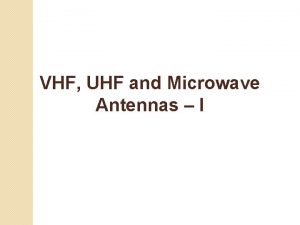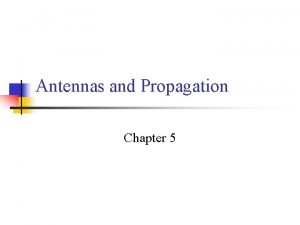Design and Optimization of Circularly Polarized Antennas for

- Slides: 1

Design and Optimization of Circularly Polarized Antennas for Mobile Shooting of Sport Events A. De Vita, A. Lucco Castello, and B. Sacco RAI Radiotelevisione Italiana, Centre for Research and Technological Innovation, Via Giovanni Carlo Cavalli 6, I-10128 Torino, Italy; A COMPACT UHF–CP ANTENNA. For live shooting sports events on the move (e. g. “Giro d’Italia” Fig. 1), it is required to develop a compact flat antenna to be hosted in the top case of the motorcycles. Circular polarization (CP) allows to avoid link degradation for any possible reciprocal orientation between the transmitting mobile antenna and the receiving one installed on the relay helicopter. Currently UHF (and legacy VHF) frequencies are used for this kind of RF link. Figure 1. Motorcycles adopted for the cycling event “Giro d' Italia” We could obtain further improved CP performance with cavity backed Dual Crossed Double Folded Dipole (DCDFD) antenna (Figs. 4 -5). COMSOL Optimization Module has allowed us to tailor the frequency and bandwidth, Figure 4. Dual crossed double leveraging parametrized folded dipoles antenna lengths of the various slots. Figure 2. Realized antenna hosted in the top case of the motorcycle COMSOL SIMULATIONS. Several possible structures have been studied analyzed using COMSOL Multiphysics. At first a two-arms UHF Archimedean spiral with reflector [1] has been optimized and prototyped (Fig. 2). The maximum allowable antenna size limits the operating range to UHF only; we then tried to extend it towards the VHF range by applying radial perturbation at the spiral periphery (so called “meander spiral antenna” [2], Fig. 3 left). Although the concept is valid, the required frequency (230 MHz) could not be achieved. Thus, the basic spiral was integrated with two inductive-loaded short dipoles, previously tuned to resonate at the desired VHF frequency (Fig. 3, right). Once optimized, this structure showed a fair performance at both desired frequencies. Figure 5. Realized gain (on the left) and axial ratio (on the right) for the DCDFD antenna. CONCLUSION AND RESULTS: The COMSOL optimized prototype has been measured in laboratory with the RFX 2 Very Near Field Scanner [3] (fig. 6); the result are in very good agreement with the simulations. The CP antenna prototype has been used during the shooting of Figure 6. Laboratory measurements on realized prototype with EM-Scan the biggest Italian cycling RFX 2 scanner. competition, in May 2019, when the performance improvement has been validated by direct comparison with the old antenna (fig. 7). Figure 7. Experimental comparison of signal received by new CP antenna (red) and old, log-periodic antenna (green) Figure 3. On the left: A two-arms Archimedean spiral antenna operating in the UHF band ( 600 MHz). On the right: A “meander spiral“ dual -band CP antenna REFERENCES: [1] H. Nakano, H. Mimnaki, J. Yamauchi, K. Hirose “A low profile Archimedean spiral antenna, ” Proceedings of IEEE Antennas and Propagation Society International Symposium, Ann Arbor, MI, USA (1993). [2] H. Nakano, “A meander spiral antenna, ” Proceedings of IEEE Antennas and Propagation Society Symposium, Monterey, CA, USA (2004). [3] EM-Scan-RFX 2 -Datasheet, Calgary, Canada. Keep this space clear for COMSOL use. Remove this text box before submitting.

